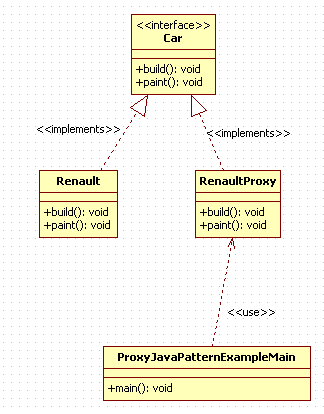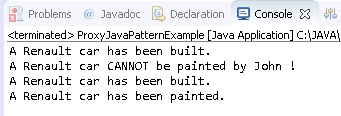#
Proxy
This tutorial explains to you the design pattern named Proxy (which is a Structural Pattern).
#
Proxy Pattern - theory
Proxy Design Pattern in Java is used when we want to create a wrapper that control the execution of the methods from
another class. Take a look at the following UML diagram representing the Proxy design pattern (for my example):
Info
In the proxy object we can add some security or monitoring features.

In Proxy Design Pattern, the main idea is to control the execution of some methods from another class.
#
Proxy Pattern - example
Here is that example using the Proxy Design Pattern in Java:
package proxy.java.pattern.example;
public interface Car {
// This method build a car.
public void build();
//This method paint a car.
public void paint();
}package proxy.java.pattern.example;
public class Renault implements Car{
public void build(){
System.out.println("A Renault car has been built.");
}
public void paint(){
System.out.println("A Renault car has been painted.");
}
}package proxy.java.pattern.example;
public class RenaultProxy implements Car{
private String userName;
private Renault renault;
public RenaultProxy(String userName) {
super();
this.userName = userName;
renault = new Renault();
}
public void build(){
renault.build();
}
public void paint(){
if (userName == "John") {
System.out.println("A Renault car CANNOT be painted by John !");
} else {
renault.paint();
}
}
}
package proxy.java.pattern.example;
public class ProxyJavaPatternExample {
public static void main(String[] args){
RenaultProxy renaultProxy1 = new RenaultProxy("John");
renaultProxy1.build();
renaultProxy1.paint();
RenaultProxy renaultProxy2 = new RenaultProxy("Dana");
renaultProxy2.build();
renaultProxy2.paint();
}
}When you run this example you will receive the following result:


